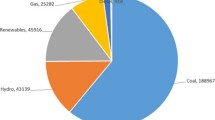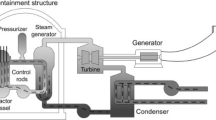Abstract
This chapter lists the capacity of commercial nuclear power plants built and operated in different countries of the world in 2013. About 80 % of all operating nuclear power plants are Light Water Reactors (LWRs), predominantly Pressurized Water Reactors (PWRs) and Boiling Water Reactors (BWRs). An additional 11 % are Heavy Water Reactors (HWRs) and 4 % are advanced gas cooled, graphite moderated nuclear power reactors (AGRs). Only about 3.4 % are Russian retrofitted RBMK1000 reactors still operating in Russia. One prototype Fast Breeder Reactor (FBR) was operating in Russia, one became operational in India and one experimental FBR was operated in Japan.
The resources of natural uranium were assessed in 2007 by IAEA and OECD/NEA to be 5.47 million tons (reasonably assured and inferred). An additional 7.77 million tons of speculative and about 4.2 million tons in the Chattanooga Shales in the USA are listed.
These uranium resources are then contrasted with the uranium consumption of each nuclear power reactor which is 171 tons per GW(e) and year for LWRs. If plutonium recycling in a closed fuel cycle is applied this uranium consumption is reduced by a factor of 1.55. FBRs would consume only 1.7 tons of U-238 per GW(e) and year which would extend the time period for nuclear energy application (uranium and thorium resources) to thousands of years.
For LWRs and other commercial nuclear reactors the natural uranium must be enriched. This is done predominantly by the gaseous diffusion and the gas centrifuge process. The laser enrichment process (SILEX) is still under deployment in the USA. Commercial spent fuel reprocessing facilities were built and are operated in France, Great Britain, Russia and Japan. This reprocessing capacity in the world can reprocess the spent fuel of about half of the presently operating LWR capacities. The majority of nuclear power plants built and operated in the world today is used for electricity generation. Such nuclear power reactors are built in unit sizes of about 1 and 1.6 GW(e) and operated for economical reasons mainly in the so-called base load regime.
Access this chapter
Tax calculation will be finalised at checkout
Purchases are for personal use only
Similar content being viewed by others
References
American Nuclear Society (2013) World list of nuclear power plants. Nuclear News March 2013. American Nuclear Society, La Grange Park, IL
International Nuclear Safety Center at ANL-Aug 2005 (2000) http://www.ne.anl.gov/research/ierc/intnlcoop.html
OECD (2008) Nuclear Energy Outlook 2008. OECD-NEA No. 6348. OECD, Paris
OECD (2008) Uranium 2007 – resources, production and demand. OECD-NEA-IAEA 6345. OECD, Paris
Kessler G (2012) Sustainable and safe nuclear fission energy. Springer, Heidelberg
Carré F et al (2009) Overview on the French nuclear fuel cycle strategy and transition scenario studies. In: Proceedings of Global 2009, Paris, Paper No. 9439
Villani S (ed) (1979) Uranium enrichment: Topics in applied physics, Vol 35. Springer, Berlin
Laughter M (2007) Profile of world uranium enrichment programs – 2007 ORNL/TM-2007/193. Oak Ridge National Laboratory, Oak Ridge, TN
Author information
Authors and Affiliations
Rights and permissions
Copyright information
© 2014 Springer-Verlag Berlin Heidelberg
About this chapter
Cite this chapter
Kessler, G., Veser, A. (2014). Introduction. In: The Risks of Nuclear Energy Technology. Science Policy Reports. Springer, Berlin, Heidelberg. https://doi.org/10.1007/978-3-642-55116-1_1
Download citation
DOI: https://doi.org/10.1007/978-3-642-55116-1_1
Published:
Publisher Name: Springer, Berlin, Heidelberg
Print ISBN: 978-3-642-55115-4
Online ISBN: 978-3-642-55116-1
eBook Packages: EnergyEnergy (R0)




